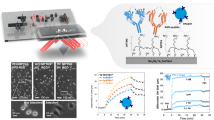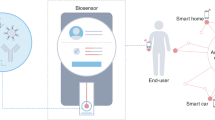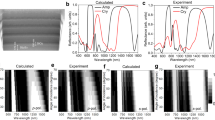Abstract
Optical sensor technology offers significant opportunities in the field of medical research and clinical diagnostics, particularly for the detection of small numbers of molecules in highly diluted solutions. Several methods have been developed for this purpose, including label-free plasmonic biosensors based on metamaterials. However, the detection of lower-molecular-weight (<500 Da) biomolecules in highly diluted solutions is still a challenging issue owing to their lower polarizability. In this context, we have developed a miniaturized plasmonic biosensor platform based on a hyperbolic metamaterial that can support highly confined bulk plasmon guided modes over a broad wavelength range from visible to near infrared. By exciting these modes using a grating-coupling technique, we achieved different extreme sensitivity modes with a maximum of 30,000 nm per refractive index unit (RIU) and a record figure of merit (FOM) of 590. We report the ability of the metamaterial platform to detect ultralow-molecular-weight (244 Da) biomolecules at picomolar concentrations using a standard affinity model streptavidin–biotin.
This is a preview of subscription content, access via your institution
Access options
Subscribe to this journal
Receive 12 print issues and online access
$259.00 per year
only $21.58 per issue
Buy this article
- Purchase on Springer Link
- Instant access to full article PDF
Prices may be subject to local taxes which are calculated during checkout




Similar content being viewed by others
References
Huang, B., Babcock, H. & Zhuang, X. Breaking the diffraction barrier: super-resolution imaging of cell. Cell 143, 1047–1058 (2010).
De Angelis, F. et al. Breaking the diffusion limit with super-hydrophobic delivery of molecules to plasmonic nanofocusing SERS structures. Nature Photon. 5, 682–687 (2011).
Zeng, S., Baillargeat, D., Hod, H. E. & Yong, K.-T. Nanomaterials enhanced surface plasmon resonance for biological and chemical sensing applications. Chem. Soc. Rev. 43, 3426–3452 (2014).
Roy, R., Hohng, S. & Ha, T. A practical guide to single-molecule FRET. Nature Methods 5, 507–516 (2008).
Poma, A. et al. Interactions between saporin, a ribosome-inactivating protein, and DNA: a study by atomic force microscopy. J. Microsc. 217, 69–74 (2005).
Anker, J. N. et al. Biosensing with plasmonic nanosensors. Nature Mater. 7, 442–453 (2008).
Zijlstra, P., Paulo, P. M. R. & Orrit, M. Optical detection of single non-absorbing molecules using the surface plasmon resonance of a gold nanorod. Nature Nanotech. 7, 379–382 (2012).
Ament, I. et al. Single unlabeled protein on individual plasmonic nanoparticles. Nano Lett. 12, 1092–1095 (2012).
Acimovic, S. S. et al. LSPR chip for parallel, rapid, and sensitive detection of cancer markers in serum. Nano Lett. 14, 2636–2641 (2014).
Im, H. et al. Label-free detection and molecular profiling of exosomes with a nano-plasmonic sensor. Nature Biotechnol. 32, 490–495 (2014).
Svedendahl, M., Verre, R. & Kall, M. Refractometric biosensing based on optical phase filps in sparse and short-range-ordered nanoplasmonic layers. Light Sci. Appl. 3, e220 (2014).
Wu, C. et al. Fano-resonant asymmetric metamaterials for ultrasensitive spectroscopy and identification of molecular manolayers. Nature Mater. 11, 69–75 (2012).
Kravets, V. G. et al. Singular phase nano-optics in plasmonic metamaterials for label-free single-molecule detection. Nature Mater. 12, 304–309 (2013).
Kabashin, A. V. et al. Plasmonic nanorod metamaterials for biosensing. Nature Mater. 8, 867–871 (2009).
Rodrigo, D. et al. Mid-infrared plasmonic biosensing with graphene. Science 349, 165–168 (2015).
Brolo, A. G. Plasmonics for future biosensors. Nature Photon. 6, 709–713 (2012).
Raether, H. Surface Plasmons on Smooth and Rough Surfaces and on Gratings (Springer, 1988).
Homola, J., Yee, S. S. & Gauglitz, G. Surface plasmon resonance sensors: review. Sensors Actuators B 54, 3–15 (1999).
Chen, H. et al. Shape- and size-dependent refractive index sensitivity of gold nanoparticles. Langmuir 24, 5233–5237 (2008).
Sannomiya, T. & Voros, J. Single plasmonic nanoparticles for biosensing. Trends Biotechnol. 29, 343–351 (2011).
Mayer, K. M. et al. A single molecule immunoassay by localized surface plasmon resonance. Nanotechnology 21, 255503 (2010).
Roper, D. K., Ahn, W., Taylor, B. & DallAsen, A. G. Enhanced spectral sensing by electromagnetic coupling with localized surface plasmons on subwavelength structures. IEEE Sensors J. 10, 531–540 (2010).
Liu, N. et al. Planar metamaterial analogue of electromagnetically induced transparency for plasmonic sensing. Nano Lett. 10, 1103–1107 (2010).
Shen, Y. et al. Plasmonic gold mushroom arrays with refractive index sensing figures of merit approaching the theoretical limit. Nature Commun. 4, 2381 (2013).
Cao, C. et al. Metamaterials-based label-free nanosensor for conformation and affinity biosensing. ACS Nano 7, 7583–7591 (2013).
Zeng, S. et al. Graphene-gold metasurface architectures for ultrasensitive plasmonic biosensing. Adv. Mater. 27, 6163–6169 (2015).
Poddubny, A., Iorsh, I., Belov, P. & Kivshar, Y. Hyperbolic metamaterials. Nature Photon. 7, 948–957 (2013).
Lu, D., Kan, J. J., Fullerton, E. E. & Liu, Z. Enhancing spontaneous emission rates of molecules using nanopatterned multilayer hyperbolic metamaterials. Nature Nanotech. 9, 48–53 (2014).
Krishnamoorthy, H. N. S. et al. Topological transitions in metamaterials. Science 336, 205–209 (2012).
Jacob, Z., Smolyaninov, I. I. & Narimanov, E. E. Broadband Purcell effect: radiative decay engineering with metamaterials. Appl. Phys. Lett. 100, 181105 (2012).
Hoffman, A. J. et al. Negative refraction in semiconductor metamaterials. Nature Mater. 6, 946–950 (2007).
Sreekanth, K. V., De Luca, A. & Strangi, G. Negative refraction in graphene-based hyperbolic metamaterials. Appl. Phys. Lett. 103, 023107 (2013).
Ono, A., Kato, J. I. & Kawat, S. Subwavelength optical imaging through a metallic nanorod array. Phys. Rev. Lett. 95, 267407 (2005).
Zhukovsky, S. V., Kidwai, O. & Sipe, J. E. Physical nature of volume plasmon polaritons in hyperbolic metamaterials. Opt. Exp. 21, 14982–14987 (2013).
Avrutsky, I., Salakhutdinov, I., Elser, J. & Podolskiy, V. Highly confined optical modes in nanoscale metal-dielectric multilayers. Phys. Rev. B 75, 241402 (2007).
Sreekanth, K. V., De Luca, A. & Strangi, G. Experimental demonstration of surface and bulk plasmon polaritons in hypergratings. Sci. Rep. 3, 3291 (2013).
Sreekanth, K. V., De Luca, A. & Strangi, G. Excitation of volume plasmon polaritons in metal-dielectric metamaterials using 1D and 2D diffraction gratings. J. Opt. 16, 105103 (2014).
Sreekanth, K. V., Hari Krishna, K., De Luca, A. & Strangi, G. Large spontaneous emission rate enhancement in grating coupled hyperbolic metamaterials. Sci. Rep. 4, 6340 (2014).
Cortes, C. L., Newman, W., Molesky, S. & Jacob, Z. Quantum nanophotonics using hyperbolic metamaterials. J. Opt. 14, 063001 (2012).
Yan, W., Shen, L., Ran, L. & Kong, J. A. Surface modes at the interfaces between isotropic media and indefinite media. J. Opt. Soc. Am. A 24, 530–535 (2007).
Baptista, P. et al. Gold nanoparticles for the development of clinical diagnosis methods. Anal. Bioanal. Chem. 391, 943–50 (2008).
Weast, R. C. CRC Handbook of Chemistry and Physics (CRC Press, 1987).
Acknowledgements
We acknowledge support from the Ohio Third Frontier Project ‘Research Cluster on Surfaces in Advanced Materials (RC-SAM) at Case Western Reserve University’. This work was also supported in part by Grant # 2013126 from the Doris Duke Charitable Foundation and by the Italian Project ‘NanoLase’-PRIN 2012, protocol number 2012JHFYMC. In addition, we acknowledge the support of the MORE Center at Case Western Reserve University and the GU Malignancies Program of the Case Comprehensive Cancer Center.
Author information
Authors and Affiliations
Contributions
K.V.S. and G.S. conceived the idea. K.V.S., Y.A., M.E., U.A.G., A.D.L. and G.S. designed the research. K.V.S. fabricated and characterized the sensor device, performed experiments and carried out numerical simulations. Y.A. fabricated the microfluidic channels, performed surface chemistry and prepared biologically relevant samples. M.E. performed experiments. E.I. and M.H. developed the theoretical models. K.V.S. and G.S. wrote the manuscript. All authors analysed the data, discussed the results, and edited the manuscript.
Corresponding authors
Ethics declarations
Competing interests
The authors declare no competing financial interests.
Supplementary information
Supplementary Information
Supplementary Information (PDF 2992 kb)
Rights and permissions
About this article
Cite this article
Sreekanth, K., Alapan, Y., ElKabbash, M. et al. Extreme sensitivity biosensing platform based on hyperbolic metamaterials. Nature Mater 15, 621–627 (2016). https://doi.org/10.1038/nmat4609
Received:
Accepted:
Published:
Issue Date:
DOI: https://doi.org/10.1038/nmat4609
This article is cited by
-
Synthesized complex-frequency excitation for ultrasensitive molecular sensing
eLight (2024)
-
Highly sensitive biosensor based on nanoparticle/grating: a case study on detecting waterborne bacteria in drinking water
Optical and Quantum Electronics (2024)
-
Highlight on commercial SERS substrates and on optimized nanorough large-area SERS-based sensors: a Raman study
Applied Nanoscience (2024)
-
Exceptional points and non-Hermitian photonics at the nanoscale
Nature Nanotechnology (2023)
-
Tunable optical topological transitions of plasmon polaritons in WTe2 van der Waals films
Light: Science & Applications (2023)



